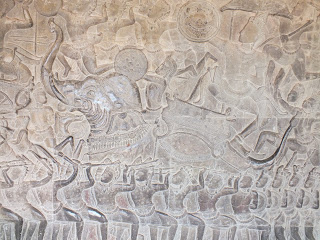(Nana and I are traveling until July 7, but we've put a couple posts in the pipeline to tide you over until then.)
I've wanted to see Angkor Wat since I was a kid. I remember sitting in the old family room in Pittsburgh watching a TV show about the Khmer temples, recently re-opened to the world after decades of civil war. Like most in the West, I had known nothing about this sprawling Southeast Asian empire, a state which I found completely unacceptable. I resolved to visit these temples, a resolution which eventually crystallized into a desire to "see Angkor Wat."
 |
| No, not on the shirt - behind you! (And all around you.) |
Of course, I wasn't the only one - Angkor Wat is now one of Asia's biggest tourist sites, bustling with sightseers even on a scorching day at the height of the Cambodian summer. Like many of those tourists, I was surprised to find that Angkor Wat, despite its size, is only a fraction of the Khmer Empire's architectural legacy. (And not even my favorite fraction - that would have to be the
Bayon.)
But I was also surprised to find that Angkor Wat, unlike so many tourist attractions around the world, actually looks
much bigger in person. None of the photos below comes close to capturing the size of the place: Angkor Wat is less a temple than it is a city, built on a scale that dwarfs any individual piece of the whole. In many ways, it is literally too big to comprehend.
 |
| The view across the moat. Those tiny-looking towers in the distance? Remember them. |
For instance: the western gate of Angkor Wat, shown below. It's larger than the central tower of most surviving Angkor temples, even after its uppermost levels have collapsed.
 |
| Just one fairly forgettable piece of the Angkor Wat complex. |
Behind that huge wall - itself behind a huge moat - is a giant plaza, with five tiny-looking towers at the far end of a huge stone causeway.
 |
| In the old days, this space would have housed a bustling holy city - built largely of low wooden structures that have not survived. |
 |
| Note how you can barely spot this building in the previous photo. The little wooden sign in front is taller than a grown man. |
Inside the western entrance to the main structure, which itself occupies less than 20% of the total footprint of the temple, are three large ritual pools.
 |
| Here's one. They're drained these days, for conservation. |
 |
| Here's another. |
Oh, and did I mention that nearly every square inch of each gallery is covered in decorative carvings?
Angkor Wat is home to bas-relief carvings at least as spectacular as those of the Bayon - though in this case they're entirely mythological or historical, whereas the Bayon reliefs include scenes from everyday life.
Of course, all of this is just the ground level of the main structure: behind and above these galleries are five high towers atop a stone terrace, representing the holy Mt. Meru of Hindu mythology.
 |
| Starting the climb. |
 |
| This picture begins to give some sense of scale: you can see the western gate below and to the left of the yellow balloon, plus the library mentioned earlier just right of center. Note that this is the view from one of the intermediate terraces - not quite the top of the temple mountain. |
 |
| Looking down on an intermediate courtyard. |
 |
| One of the four "smaller" towers atop the central structure. |
 |
| The central tower itself - tall in its own right, even if it weren't atop a high terrace. All together, the tower is 65 meters (about 215 feet) off the ground. |
So how does one even begin to understand such an enormous structure? One common way is to contrast Angkor Wat with the Bayon (reminder: the one with all the face towers): Angkor Wat is huge, classical, symmetrical, impressive; the Bayon is small, ornate, asymmetrical, intimate.
Another is the tried-and-true archaeological method of extrapolating (sometimes wildly) from tiny details. For instance: Angkor Wat is oriented to the west rather than the east and its mythological bas reliefs are read in reverse of the usual order, just like the rituals in a Hindu funerary rite. Thus some claim that Angkor Wat must be the world's largest mausoleum, giving
Suryavarman II the standing record for world's biggest grave. Then again, there are a half-dozen competing theories to account for all of Angkor Wat's numerous quirks.
On a personal level, even a couple months later, we're both still processing this experience. As a building, Angkor Wat it simply larger than a single mind. Which makes sense, as its design and construction involved countless thousands of laborers and artisans, each of whom shaped the final product over the decades of its construction. Even today, the people who use the site continue to shape it: there are active Buddhist shrines scattered throughout the structure . . .
. . . coupled with ongoing efforts to restore and conserve Angkor Wat for future generations.
 |
| A badly weathered face of the central tower. |
 |
| Restoration work on one side of the central tower. |





























No comments:
Post a Comment